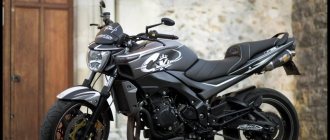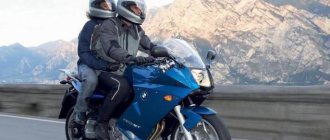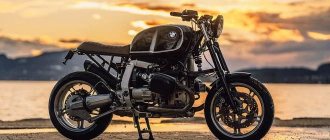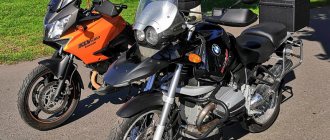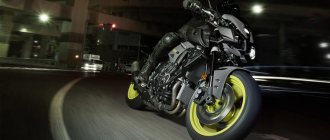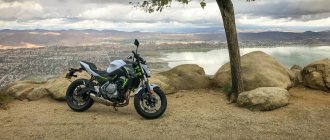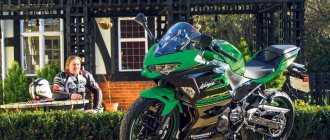Development, markets and modifications
Structurally, the bike is a good old classic - a V-shaped two-cylinder engine, a steel duplex frame, and a conventional telescopic fork.
Many people tend to call them modifications. In 2003, the last motorcycle rolled off the assembly line.
As is customary among the Japanese, the development was intended for domestic markets. A more powerful Kawasaki VN800 model (and then VN900) was assembled for export.
But interest in medium-sized technology led to the fact that the 400 could be bought outside the country, including in Russia.
True, deliveries were made through “gray” sellers, with all the consequences - lack of parts, authorized representatives, and branded service. But the model was so simple that this did not bother buyers. The bike can still be bought at Japanese auctions, and in other countries - on the secondary market. According to users, if you search you can find a very good version with minimal mileage in Russia.
History of changes
The bike has undergone a number of major changes, but the overall picture remains similar. Something was adjusted, something was replaced with something completely different:
- 1990 – the beginning of production, the first generation saw the light;
- 1996 – a turning point, second generation;
- 2009 is the last year of production, the model has not changed since ’96.
Technologies from the Kawasaki EN 500 Vulcan have migrated to new models of the Vulcan line. This same motorcycle is worthy of remaining in the memory of bikers, because the equipment is an example of a high-quality classic Japanese motorcycle.
Specifications
Much of the interest in the model is due to the presence of a V-shaped engine. Experienced drivers know that this arrangement provides traction throughout the entire rev range.
Engine – left view.
Engine – right side view.
But simplicity of design, liquid cooling (despite the small volume) and, of course, proven technologies also played a role (the latter was largely due to the assembly of an export “volcano” next door). The total result is a motor of the following type:
- working volume - 399 cm3;
- number of cylinders - 2 (V-shaped pistons);
- number of cycles - 4;
- number of valves - 8 (4 per cylinder);
- power - 33 hp;
- torque - 32 Nm;
- cooling - liquid;
The cooling system radiator is squeezed between the pipes of the steel frame.
- fuel supply - Keihin carburetor (1!!!);
- ignition - transistor (TDI);
- start - electric starter;
- tank volume - 15 l.
A special highlight of the engine, according to the manufacturer, was the presence of one (1) carburetor with two (2) cylinders.
“We need to travel more and repair less!”
Transmission and clutch
The main drive is a classic chain drive.
As befits a cruiser, the bike had a 5-speed gearbox .
It shifted clearly, but had a short pedal travel.
It was also noted that you have to click very often, since the numbers are tightly adjusted - the average step is 10 km. Another frequently discussed problem was finding neutral. Especially after stopping the bike with the brakes.
- Multi-disc clutch in oil bath. Power transmission is a cable .
- The main drive according to European standards is a chain .
Brakes
Front disc brake.
Rear drum brake.
The export bike owes its brake system to this particular model. They changed here and changed there too. In 1996, a 2-piston caliper was installed on the front axle. In 1999, a disc appeared on the rear axle (replacing the drum).
Front:
- number of disks - 2;
- diameter - 300 mm;
- support - 2-piston (until 1996 - one piston).
Rear:
- number of disks - 1;
- diameter - 270 mm (drum diameter - 180 mm);
- support - 2-piston.
No options were offered.
Suzuki C800
Last on the list is Suzuki. With the introduction of the black model (along with its big brother, the C1500BT, which I once tested), the 800 came to my attention, particularly after I rode it at Motorbeurs in Utrecht. After reading many positive reviews, the Intruder is firmly at the top of my list of preferences. A nice feature is the presence of almost a cardan, which for some reason always seemed to me the least demanding option, the highest ground clearance in the class (link). There is a version with bags and a windshield (Light Cruiser package), although the original bags are only soft. In terms of instrumentation, Suzuki is quite advanced, with a modern LCD fuel gauge and even an indication of the gear engaged (I’ve never had one, maybe I should? :)).
Among the shortcomings, it is worth noting the small capacity of the gas tank (15.5 l), the drum brake at the rear (okay, not a carburetor engine...) and the “overly” classic lines of the wings, but, as a true lover of the classics, this should not bother me :). In the Belgian review, the author managed to “throw” the motorcycle from side to side on a circle so actively that the gas pump refused to pump gasoline at the last quarter of the tank indicator, but I haven’t read anything like this from anyone else and I personally couldn’t do it :).
Update. After a couple of additional “sitting” tests, I finally came to the conclusion that the seating position is too “relaxed” for my height - my arms are half-bent, but I would like (especially for long trips) a more straightened “configuration”. On the C1500, with a straight back, the palms rest clearly on the handles, and on the 800, the hands rest on the handles above the wrists. Most likely it can be “treated” by installing a custom steering wheel. Need to think…
Reviews
- Available in Belgian MotorLife (Dutch)
- Owner's review from MotoDrive magazine
- Intruder C800 review on KB
Read the third part of the article about choosing mid-sized cruisers.
Exterior photo
Round headlight.
Back light.
Separate seats.
Abundance of chrome.
Stock mufflers.
Low steering wheel.
Video
- A quick look and sound of the Kawasaki VN1600 Vulcan Mean Streak motorcycle.
- A quick look and sound of the Kawasaki VN1600 Vulcan Nomad motorcycle.
- A quick look and sound of the Kawasaki VN1600 Vulcan Classic motorcycle.
Kawasaki VN 1600 Vulcan
- a model that in 2004 replaced its one and a half liter predecessor, which lasted on the assembly line for several decades. In fact, the VN1600 is simply a modernization of the 1500 cc model - the same steel frame, the same cardan drive, the same liquid-cooled V-twin... Except that the carburetor power system was finally replaced with an injection one. The Vulcan 1600 was produced for five years, and was discontinued in 2009, giving way to a completely new model - the VN1700.
At first glance, the Kawasaki VN 1600 is not so different from its predecessor. Externally, it is very similar to the Vulcan 1500 of the latest generation, and its technical characteristics have not changed very significantly - the power has increased to 66 hp, however, the torque has increased to 127 Nm, with its peak already at 2700 rpm, which provides “ Vulcan" has excellent low-end traction. In general, the character of the motorcycle is very similar to that of the Suzuki VL1500 and Honda VTX 1300.
VN 1600 Purely externally, it’s still the same good old “Vulcan”, somewhat subtly reminiscent of classic Harley-Davidson models. By the way, compared to the Vulcan 1500, the Kawasaki VN 1600 has only three models - a classic, a touring one called Nomad, and a Mean Streak, to which we have a separate article. The classic version is just a cruiser without any body kit, while the VN1600 Nomad comes standard with plastic saddlebags, a windshield, a passenger backrest and a dual-sided exhaust.
The first impression that comes to a motorcyclist who sits on the VN1600 is how big it is! Yes, the dimensions of this bike are really impressive, and it weighs a lot - more than 300 kg, and the Nomad version is even under 350. However, thanks to the low center of mass, the weight of the motorcycle does not become a problem, and the modest height of the saddle, coupled with the forward position driver's platforms allows a person of any height to sit confidently and comfortably in the saddle of the Kawasaki VN 1600.
The dynamics of this motorcycle correspond to its volume and class - a lot of lows, few highs... classic, what can you say. The Vulcan 1600 is a typical cruiser with all the advantages and disadvantages typical of this class. Accelerating to 100 km/h in less than 5 seconds, it still seems to hint to the owner that his element is not slalom between cars, but a leisurely journey along an empty highway full of pleasant impressions. Of course, you can crawl through traffic jams, but the real pleasure of driving the Kawasaki VN 1600 comes on the track. Comfortable and convenient, it does not make you want to change anything about it, for example, the steering wheel or seats.
The VN 1600's brakes and suspension are also fairly typical by class standards. At the front there is a 41 mm fork with 150 mm travel, at the rear there are double shock absorbers with 99 mm travel, which, by the way, some owners complain about - reviews often say that on a bad road and when the motorcycle is fully loaded, they regularly hit all the way. But the brakes deserve more flattering reviews - two 300 mm discs with 2-piston calipers at the front and one 300 mm disc with the same 2-piston caliper at the rear. The Kawasaki VN 1600 brakes effectively, this cannot be taken away from it.
Sharpness and ease of control have always been the strong point of the Vulcan line, and the VN 1600 was no exception. In static conditions, the motorcycle seems really heavy if, for example, you start rolling it with your feet in the parking lot, and it’s scary to tilt it, but as soon as it starts moving and picks up 10-15 km/h, all this feeling of heaviness immediately evaporates. Well, on a long journey, the motorcyclist will more than once be pleased with the spacious 20-liter gas tank and moderate consumption of about 6 liters of gasoline at a cruising speed of 120-130 km/h.
To sum it up, we can say that the Kawasaki VN 1600 is a typical cruiser, nothing more and nothing less. In some ways it is inferior to its competitors, in some ways it is superior to them, but, be that as it may, it remains a bright representative of its class. A high-torque V-twin, a cardan drive, an injector, a solid gas tank, an abundance of high-quality chrome sparkling in the sun, a stylish appearance a la “timeless classic” - what else is needed for happiness?
Driving performance
The maximum speed indicated in the documents is 140 km/h . In Japanese tradition, there is no wind protection in the drain. But users noticed that it is not needed to reach the maximum speed. At the same time, it was separately mentioned that the engine is powerful - in a cruiser you can go at 120 km/h and 125 km/ h without any problems.
The dynamics of acceleration to 100 km/h for a small cruiser is 8 seconds . Considering that the older brother shows almost 7 seconds. - This is fine .
Fuel consumption
Consumption, subject to city driving with rare trips to the village to visit grandfather - 4 liters per 100 km .
On the run
Vulcan's element is “secondary” roads.
80-90 km/h is the swan song. It goes along with the engine purring quietly and providing the rider with an excellent opportunity to admire the road and surroundings. But this is kind of expected from this class of motorcycles. Turns are surprisingly easy and relaxed, you just go into them yourself. I don’t “lay down” the motorcycle in a turn, so the lean was enough for me. After all this positivity, it was, of course, interesting to check out the motorway. And then a couple of shortcomings emerged. Firstly, the windshield turned out to be “just the wrong size.” In other words, my head was exactly in the turbulence zone, as a result of which it was absolutely impossible to drive more than 120 km/h - the helmet vibrates so much that my vision is blurry. Nekarasho.
Secondly, the limit of the engine showed itself
Even if you do not pay attention to the turbulence, then with constant uniform movement I caught myself subconsciously maintaining the speed at 110 km/h. And it seemed like he was “correcting” himself, but then he still “moved” to 110
Apparently this is the “correct” cruising speed for this device. You can, of course, accelerate, but it does not provide pleasure, and acceleration takes quite a noticeable amount of time. When it became necessary to overtake a number of trucks and change lanes into an exit lane, the maneuver had to be carried out with the throttle turned to the maximum and a leisurely calculation of time. At the same time, a decent amount of trembling from the engine is felt on the footrests and the mirrors fog up to zero. But the vibration is not felt on the handles. Apparently, Vulcanchik was not created for the autobahn. More likely for leisurely trips. Which also has its right and advantages!
One funny thing is that when you turn the throttle, you hear a noticeable “clack”. When you let go, it clicks again. Looks like “that’s how it should be.”
As usual, a short video with the sound of the engine with a standard (factory) exhaust:
Dimensions and weight
Since the bike has survived three generations, all external parameters have also changed three times, and, almost always, upward.
The dry weight of the bike has increased from 225 kg to 250 kg .
Equipped, taking into account the tank and all liquids, 20 kg more. Accordingly, 245–270 kg .
It is curious that the overall dimensions of the second generation, with the exception of width, were smaller than the first (naturally, smaller than the third). For comparison, the parameters of all three generations;
- length - 2360-2345-2480 mm;
- width - 825-930-1005 mm;
- in height - 1170-1130-1125 mm;
Seat height - 710-700-760 mm .
Wheelbase - 1625-1600-1615 mm .
For whom is it intended?
This issue can be ignored, given that the motorcycle was supposed to be sold only in Japanese markets.
Despite three generations, the saddle height offers a comfortable ride only for short users or girls.
The soft and very comfortable seat makes you feel like in your favorite chair.
For a Russian of an export model was recommended for purchase .
Box
The box was a very pleasant surprise. The gears are engaged softly and accurately, with the same “oil-lubricated clatter” and the same feeling. No jerking when shifting up or down. I was even surprised. It's just a real pleasure to switch. Compared to the “unbroken” custom Yamaha (apparently, the issue is rather a matter of cubic capacity) it’s simply silky.
In general, the box is configured in such a way that you need to switch (close enough to each other). On a Yamaha you could ride in second or third, but here you can use all gears. At 80 km/h you can safely drive in 4th gear. You can switch with both your toe and heel. In principle, not a problem, but in order to switch with the heel I had to move my foot “backwards”; nevertheless, switching with the toe in this regard is much more convenient (without unnecessary body movements). As a result, for the most part, I switched with my toe out of habit, but I can imagine that sometimes it’s convenient with my heel if I’m not in a hurry :).
Modifications
During the production of the motorcycle there were three modifications.
- Kawasaki Vulcan VN400 A and Kawasaki Vulcan 400 V. Production of the model began with them. They existed on the assembly line for three years. 1995-1998. The first model had a belt drive, the second - a chain. A limited batch of the first ones was sent to America - but were not successful. The second model was officially supposed to remain only in Japan and in domestic markets was also designated as Vulcan II. The main difference between both versions is the Harley-Davidson Softail style design.
- Kawasaki Vulcan VN400 C (Classic) . Production began in 1996 . I got the same wheels 16/16 versus 21/18 for the first versions. Extended wings, like a road worker’s + a small mudguard. Black color (except for engine covers and exhaust pipes.). Produced until 2003. This and the next model already have a 14 liter tank.
- Kawasaki Vulcan VN400 D (Drifter). While the first versions borrowed design from Harley-Davidson, this one takes advantage of the developments Indian (not to be confused with the country of the same name - Indian Motocycle Manufacturing Company is located in the USA). Recessed fenders now cover the sides of the wheels, two muffler banks have been combined into one, and the saddle has been changed. Started in 1999, was released before production was completed.
Vulcan VN400 Drifter is an Indian-style version of the motorcycle.
It is worth noting that neither the letters in the name, nor the more odious name of the third model, carried any hidden meaning.
Competitors
The model turned out to be so unusual that representatives of other American brands could not imagine an equivalent one. However, not wanting to give the entire pie (market) to Kawasaki, they offered a couple of analogues at once.
Honda
Honda Steed 400 is a light cruiser designed for American needs.
Honda offered its developments Honda Steed 400 and Honda Shadow 400.
- The first featured three valves per cylinder.
- Two carburetors.
- A tank of 10 liters , with a flow rate of 5 liters .
- Production started in 1988 .
- Closed in 2001.
In addition to the above, individual modifications of the second version (Shadow) could boast an injector and a driveshaft. Fuel consumption was comparable to the first model.
The model started in 1997 and ended in 2016 .
Yamaha
Yamaha XV400 Virago - a cruiser intended for the domestic market.
Yamaha's answer was the Yamaha XV400 Virago and Yamaha XVS400 Drag Star.
Interestingly, according to the developer documentation, the second is the successor to the first. Both bikes differed from the Kawasaki by being air-cooled and having a pair of (2) valves per cylinder. Both had a driveshaft, the rear shock absorber was also different. Virago had a pair of springs (versus one), the star had a rear progression. The gas tank of the first was 13 (consumption 6) liters, the second - 15 liters (consumption 3) liters. The first started in 1987 , closed in 1994 , the second opened in 1996, existed until 2021.
Suzuki
Suzuki Intruder VS400 is a rather rare representative of serial choppers.
Suzuki did not lag behind either. For the first version he proposed the Suzuki Intruder VS400 , and for the rest the Suzuki Intruder VL400 Classic.
- The VS400 boasted a driveshaft, a carburetor hub, and a pair of springs on the rear shock absorber. 12 liter tank and consumed 4 liters . The production opened in 1994 and closed in 1996.
- The VL400 also received a driveshaft. The second generation versions were equipped with an injector. The tank is 17 liters , with a consumption of 3 liters . It is the successor to the previous model. Opened in 2001, closed in 2021.
Tire selection
Both of these motorcycles are built from road bikes and are not choppers in the generally accepted sense.
And they got the tires from road donors, and their size too. It won’t be easy to find something classic old-school cruiser in 17” sizes, so I don’t even recommend thinking about it. Buy something sporty and touring and be happy. For a Honda with a 17” front wheel, the choice is wide. Not so long ago, 120/70 + 160/60 was the industry standard for 600 naked bikes and supermotos. There are no difficulties with the choice. If the financial issue is not pressing, then Michelin Road 5 or the previous model Pilot Road 4 and 3, Pirelli Angel GT and ST, Metzeler Roadtec 01, Dunlop Roadsmart III
If you are pressed, then pay attention to Shinko Verge 011 or budget series of famous manufacturers: Michelin Pilot Street Radial, Pirelli Diablo Strada, Metzeler Roadtec Z 6. If you want to add a little scrambler notes to the appearance of the motorcycle, then you can look at slightly toothy tires like Pirelli MT 60 RS Corsa or Heidenau K 73 Superrain
You can also install slicks, but it will look stupid.
The Kawasaki is a little more difficult because it has an 18" front wheel. This slightly narrows the list of models available as a set. Michelin will be available Pilot Road 3 and 4, but there will be no “fifth”, or Metzeler Roadtec Z 6-Z 8 and 01, Pirelli Angel GT and ST, Dunlop Roadsmart III and the same Shinko 011. Of the “something” options “more toothy” is only the Pirelli MT 60 RS Corsa.
Remember that any modern sports-touring tires exceed the grip capabilities, both power and geometric, of these motorcycles. Don’t get hung up on searching for just one brand – there are a lot of good tires in the world, and you can always find something tenacious, long-lived and inexpensive. You just need to know what and where to look.
Peculiarities
With the exception of 1 carburetor operating on a pair of cylinders, users do not note any other features.
True, there are several jambs when servicing:
- When adding antifreeze, you will have to climb into the gas tank or remove the speedometer. Both plugs are closed by one hatch.
The speedometer is located directly on the fuel tank, with warning lights below.
- When replacing the spark plug on the first cylinder, remove the gas tank. To replace the second one, remove the saddle.
The fuel tank practically lies on the cylinders; the most that can be done is to remove the spark plug cap.
Some call it a noisy gearbox. But as the developers say, this is not a bug, this is a feature . Boxes on any motorcycle of the brand are characterized by excessive noise.
Comfort
Firstly, it’s worth talking about the noise level. This one is small, thanks to the belt drive. This distinguishes the Kawasaki VN 1700 Vulcan from many other representatives of the brand.
As a result, when changing gears, there are no various clanging and other unpleasant sounds that certainly accompany chain drives and cardan shafts.
Secondly, the motorcycle does not fall over when cornering, even at low speeds, which makes it convenient for city yards
It is important to note the quality of the materials from which the seat is made.
However, there is also a drawback. The instrument panel is inconvenient to look at due to the fact that it is located low. However, this is also what makes for great design. This is not to say that this is a big minus.
From many first-person videos it is clear that if desired, the driver will not have any difficulty looking at the panel. It's just not as convenient as on many other models. But definitely nothing will interfere with the view.
As for the speedometer, everything is not clear. Miles are poorly distinguishable, but kilometers, on the contrary, are well distinguished. So comfort here depends directly on what country the owner of the motorcycle lives in. But, of course, it would be better if all the speedometer readings were clearly visible.
Flaws
The owners do not find any particular disadvantages in their “iron horse”, with the exception of one, which consists of several. This is a mono-shock absorber - rear suspension .
- The main disadvantage that everyone faces is attaching it to the frame. Since it is located below the frame itself, when driving into a garage or a small hill it is easy to “sit down” on it. And since they saved on metal, the fastening instantly flies off. And this is not a warranty repair (especially if you remember that the bike can now only be bought on the secondary market).
The rear shock absorber is the weakest point.
The monoshock absorber mount is located below the frame.
- “Powerful” bikers faced the second disadvantage. Perhaps in Japan it didn’t feel that way, but it’s better not to drive on Russian roads when they’re loaded. One guy weighing 90 kg . If two sit down, a breakdown is guaranteed.
But they also note the carrying capacity. Although there is space under the case, it’s not worth putting anything heavier than a motorcycle helmet there. The total weight indicated in the specifications is 300 kg. Of which 190 are the motorcycle itself. Two passengers of average build are already an overload. You can leave, but it will be faster on a scooter.
and dignity
Perhaps the most important advantage of the bike is its high reliability.
There are also advantages:
- Low fuel consumption.
- Well managed.
- Maneuverability.
- Easy to maintain.
- reliability.
- small Harley.
And they also note the low center of gravity and weight . Whether this is a plus or a minus, everyone decides in their own way. Due to the low center, it holds the track well. Large weight - maintains direction in crosswinds.
Devices
Vulcan turned out to be quite modest in terms of instruments. The navigator has nothing to do here :). There is the required minimum, but no more. A speedometer, a couple of lights and, oddly enough (and nicely), a fuel gauge. In general, a minimal gentleman's set for every day. Everything is quite readable, but the bottom three lights should only be viewed with your head down.
In addition to the windshield and bags, the package of the “light cruiser” also includes an additional set of lamps (popularly called a “chandelier”). In fact, the pleasure turned out to be dubious, especially since one of them had already broken down (according to the seller, the bike is regularly kept in the garage for minor repairs; we’ll consider it a “feature” of the rental bike). But this is not the most interesting thing. The “lighting devices” are controlled by a button on the left of the additional headlights. Accordingly, you can turn it on only by getting off the motorcycle and pressing the button. In general, either ride “with a chandelier” or not at all, sir.
